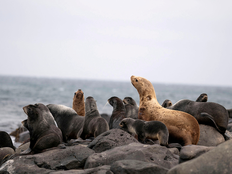A record number of financial institutions are expected to attend the conference starting in Montreal

Article content
The most important gathering on biodiversity in a decade is kicking off this week in Montreal, where countries will negotiate an ecological deal that could hold equal significance to the 2015 Paris Agreement on climate change.
Advertisement 2
Article content
That’s because scientists view biodiversity as one of the chief weapons in combating global warming. Protecting the world’s ecosystems, and the diverse life within them, from destruction, pollution and other threats, also means protecting natural carbon sinks that absorb emissions.
Article content
Businesses are increasingly interested in meeting their ESG goals through biodiversity measures — such as forestry preservation — and a record number of financial institutions are expected to attend the conference known as COP15.
The United Nations-run gathering will have representatives from 191 countries and follows COP27, a larger UN summit focused on climate change that took place in Egypt last month.
COP15 runs from Dec. 7 to 19. Here’s what you need to know:
Advertisement 3
Article content
What’s on the table
Representatives are negotiating the wording of an agreement that lays out four long-term biodiversity goals for 2050 and 23 specific “action targets” to be completed by 2030, according to a news release from the UN on Sunday. The latter group includes eight targets to protect biodiversity, and five geared at making sure humans use nature sustainably and share its bounties and benefits equitably. The remainder are tools and solutions to achieve those targets and goals.
The final text requires unanimous agreement to pass.
Who will be there High-level talks will be handled mainly by environment ministers. The work builds on goals first established by the UN Convention on Biological Diversity, which was signed 30 years ago at the Rio Earth Summit and has been ratified by nearly 200 countries.
The U.S., which has not ratified the convention, is expected to play a key behind-the-scenes role as a COP15 observer, given recent progress in this area under President Joe Biden. That includes his appointment of a special envoy for biodiversity and water resources, the Inflation Reduction Act, and a new report on nature-based solutions for climate unveiled by the White House at COP27.
Advertisement 4
Article content
About 1,400 organizations — including NGOs and businesses from 103 countries — will attend the conference as well. Support from the financial sector is seen as key to successfully implementing an agreement because funding to support biodiversity measures is currently far less than various estimates of what’s needed. Antonio Guterres, secretary-general of the UN, will help open the event.
Who won’t be there
World leaders are unlikely to attend but fewer speeches and less pomp and circumstance may be a good thing in terms of getting more technical work done. Canada’s Prime Minister, Justin Trudeau, will be the notable exception, given Canada is the host country. (Technically this meeting should be taking place in China, which holds the COP15 presidency, but it was moved due to COVID lockdowns.)
Advertisement 5
Article content
Five Things to Watch
Targets and goals for 2030: The biggest news to come out of COP15 would be a consensus on what’s known as the “30 by 30” target. It asks countries to commit to protecting 30 per cent of the world’s land and sea by 2030, including key ecosystems around the world. “It has gained enough support prior to the meeting to stand a high chance of landing. But it isn’t a foregone conclusion,” says Alistair Purdie, an analyst at clean energy research group BloombergNEF and lead author of a recent report released by the group ahead of COP15. “Brazil, Indonesia and South Africa are yet to commit, so compromises from developed countries in other areas like finance and genetic resource benefit sharing will need to be made.”
Advertisement 6
Article content
Genetic resource sharing means distributing any benefits — including profit — that come from using genes found in the world’s living organisms to create new products. Agriculture is an obvious example: much of the genetic information used to create new, drought-resistant crops comes from plants in the Southern hemisphere but the companies developing them are typically in the north. Medicine would be another example.
Targets and goals for 2050: An agreed goal to not only halt, but also start to reverse biodiversity loss by 2050 would be meaningful. That would likely mean enhancing the world’s natural ecosystems, tackling extinctions, and maintaining genetic diversity among the planet’s lifeforms. This could be expressed merely as an aspiration or backed up with numerical targets.
Advertisement 7
Article content
BNEF’s report puts the chances of a meaningful deal at fifty-fifty but says, if it happens, COP15 could be as significant as the 2015 Paris Agreement.
‘Nature positive’ language
The idea of stopping and eventually reversing biodiversity loss — a strategy known as “nature positive” — is becoming the new “net zero” in terms of planet-friendly guiding principles for nations and businesses. The concept underpins many proposals in the draft agreement. Target 18, for example, calls for slashing government subsidies and incentives that harm biodiversity by at least US$500 billion a year, and ensuring future incentives are at least neutral and increasingly positive.
Business requirements
To get companies to adopt nature positive practices, businesses and financial institutions could be required to track and disclose their effect on biodiversity. The aim would be to cut negative impacts by at least half by 2030, with a gradual increase toward positive impacts. The trick will be measuring progress, according to Jessica Smith, nature lead at the United Nations Environment Programme Finance Initiative. Unlike emissions, she says, changes to ecosystems aren’t tracked a single way. The Taskforce on Nature-related Financial Disclosures has been making progress on identifying metrics, Smith says, and could lead the way on this. “We need a really robust definition of nature positive,” she says.
Advertisement 8
Article content
Biodiversity finance
Lack of financing was one of the reasons the last biodiversity agreement, struck in 2010, failed to meet its targets. The COP15 framework identifies a global gap of US$700 billion a year that would need to be bridged for success. In their report, BNEF analysts note this is “seven times larger than the finance goal that has proved a pinch point in climate talks.” Target 19 calls for at least US$200 billion a year in financing by 2030 to narrow that gap. The elimination of half a billion dollars worth of harmful subsidies per year would make up the rest.
Significant financial “capacity building” will be needed to free up funds, says Ryan Riordan, research director of the Institute for Sustainable Finance at Canada’s Queen’s University. “We need to develop the tools, and the methods, and the technology to value this stuff better,” he says. “It’s really easy for us to take a look at balance sheets and income statements of firms. How do we do that for habitats, or salt marshes, or peat bogs or coral reefs?”
Advertisement 9
Article content
-

Hundreds of businesses call on governments to require them to release biodiversity data
-

At COP15, business will hear that it can’t afford to ignore the biodiversity crisis anymore
-

China touting ‘ambitious, pragmatic’ biodiversity pact from COP15 conference set for Montreal
Just as governments need a way to measure nature-positive impacts, the financial sector needs to be able to place a dollar value on biodiversity improvements or avoiding degradation. Some of the solutions being discussed within the financial community include a biodiversity index or biocredits.
Indigenous Rights
There is a growing recognition of the value indigenous peoples can provide as stewards of biodiversity. The current framework aims to make sure their traditional knowledge guides biodiversity decisions, their consent is given, and their rights are upheld. It also acknowledges that decision-making, and benefits to natural systems, need to be shared equitably among people, cultures and countries.
—With assistance from Natasha White, Eric Roston and Mathieu Dion.
If you liked this story, sign up for more in the FP Energy newsletter.




